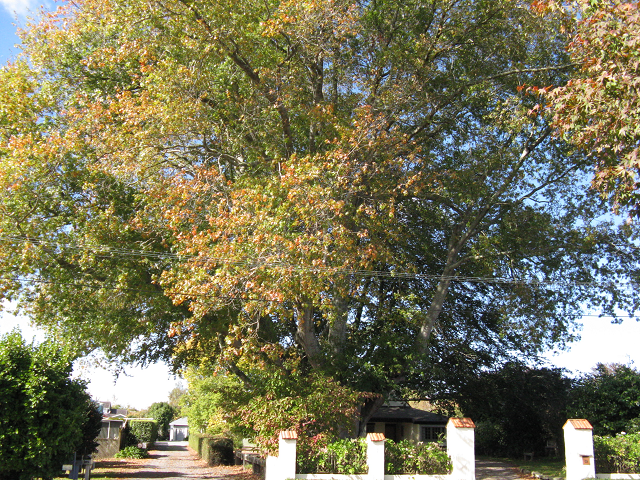Notable trees
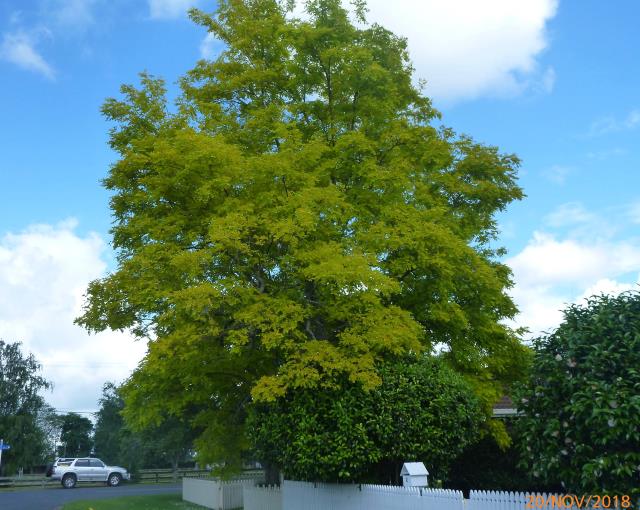
Black locust (Robinia pseudoacacia)
Originally a native of the Allegheny Mountains, USA, this broadly columnar, deciduous tree is now widespread throughout the Americas, Europe and Asia. Its Latin name is after the head gardener to Henri IV and Louis XIII of France, Jean Robin (1550 -1629), who received plants from Canada. Its common name was given to it by Jesuit missionaries in the Americas who thought it was the tree that had supported St John in the wilderness, not knowing that it was neither a true locust, nor native to the Middle East!
Growing to between 30 and 50 feet in height, it is suitable as a medium garden or street tree. Pollution-tolerant, its height lends proportion to the streetscape. The delicate compound leaves turn yellow in autumn and are not a problem to dispose of. In spring, it has drooping racemes of white, scented flowers which look rather like wisteria and are attractive to bees. Indeed in the eastern USA Robinia is a major honey plant. In autumn, flowers are followed by pea-like pods about 100mm long.
In New Zealand Robinia is mainly grown as an ornamental tree, but around the world it is put to many practical uses, a veritable one-stop-shop. Traditionally the Cherokee used the beans as an emetic, and a painkiller for toothache. It also has astringent, diuretic and sedative properties. The flowers contain benzaldehyde, which has an almond-like odour. They are used in Romania to make an aromatic jam, and in Italy and France they are battered and fried in oil. The deeply furrowed grey bark is yellow inside and is used for dyeing. The wood is hard and strong, rot resistant, and competes with hickory for its high-lustre finish. It is used in boat building, flooring, furniture making, veneer, and also railroad ties and mine timbers. In India, Robinia is grown in coppiced plantations, completing the harvest cycle in a mere 27 years. It will grow in most well-drained soils and with its dense root system is excellent for erosion control, while its nitrogen-fixing abilities enrich poor soils.
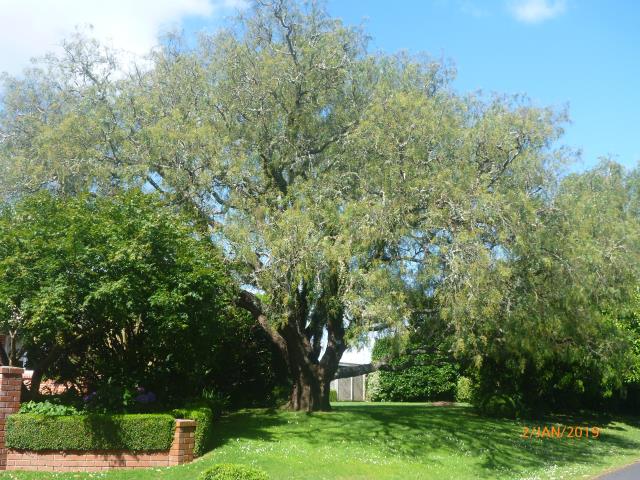
Peruvian pepper tree (Schinus molle)
This lovely specimen in Hemans Street was once on the Protected Tree list but has recently been delisted. Schinus molle is native to southern and western parts of South America, the dry regions of the Andes. In really hot, dry positions in sandy or stony soil it will be no more than a large bush, but on dry river beds where underground water is available it may grow to 15 metres in height, with a delicate weeping crown similar to this Leamington tree. It tolerates both salinity and alkalinity, and near the equator is found at altitudes up to 3900 metres.
It was traditionally used by the Inca people for textile dyeing and for embalming the dead, and also as a source of food. The essential oils in the leaves were used as a peppery spice in baking and candy, and the pink seeds were, and still are, often used as a pepper substitute. The ripe berries were used to make a drink, or mixed with maize to make a thick gruel. Even before the Inca, the Chicha people fermented the berries to make an alcoholic liquor, now called capaloclea.
The tree also has a long medicinal history as a source of anti-bacterial, anti-fungal and anti-depressant medicines. The bark, with diuretic and astringent properties, was used to treat diarrhoea, inflammation and tumours, and when heated the gum from the bark could be chewed as a purgative and digestive aid. The leaves served as a stimulant, an insect repellent, and a treatment for rheumatism.
Today in South America Schinus molle is often used for soil conservation, offering both erosion control and increased soil fertility from the 25% of its leaves which fall each year.
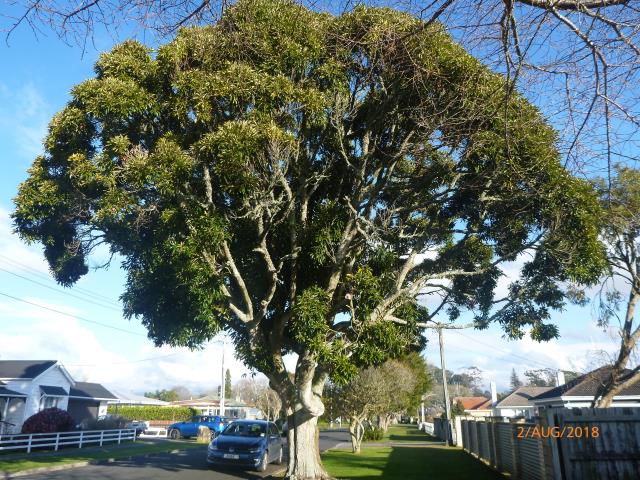
Japanese evergreen oak (Lithocarpus edulis)
Here’s an unusual one! Not only is it included in the list of notable Cambridge trees but also, sadly, on the International Union for Conservation of Nature’s (IUCN) Red List of threatened plants. Located near 24 Stafford Street, this architectural variety of "stone oak" with its dark, glossy, leathery leaves, slender, spikey, cream flowers resembling those of the Spanish chestnut, and seeds that resemble acorns, is now mainly an ornamental tree which can grow to 15 metres.
The nuts are actually edible, but because they contain bitter tannins are usually soaked in water before being dried and ground into meal for thickening soups and making bread or porridge. The bark of the tree is also rich in tannins and was used in the past as a dye and preservative for ropes. The wood is very hard and heavy and used mainly for fuel.
There are several different species of the genus lithocarpus; they include a tropical variety from South East Asia which grows to 30 metres in height, and a temperate variety from Oregon, USA which reaches only 10 metres. All, however, are found in lower montane forests growing on slopes with moist but well-drained soils.
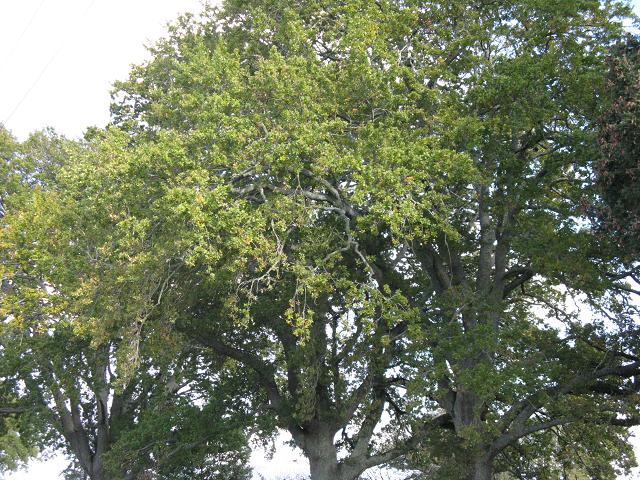
Quercus robur (Latin quercus, "oak" + robur "strength") is the species by which the oak genus is defined, and a member of the white oak section.
Quercus robur is a large deciduous tree, with circumference of grand oaks from 4 m to exceptional 12 m. The Majesty Oak with a circumference of 12.2 m is the thickest tree in Great Britain.
Quercus robur has lobed and very short-stalked leaves 7–14 cm long. Flowering takes place in mid spring, and the fruit, acorns, ripen by the following autumn. The acorns are 2–2.5 cm long, pedunculate (having an acorn-stalk, 3–7 cm) long) with one to four acorns on each peduncle.
Q. robur is very tolerant to soil conditions and the continental climate, but it prefers fertile and well-watered soils. Mature trees tolerate flooding.
It is a long-lived tree, with a large wide spreading crown of rugged branches. While it may naturally live to an age of a few centuries, many of the oldest trees are pollarded or coppiced, both pruning techniques that extend the tree's potential lifespan, if not its health. Two individuals of notable age are the Stelmuze Oak in Lithuania and the Granit Oak in Bulgaria, which are believed to be more than 1500 years old, possibly making them the oldraest oaks in Europe
Within its native range Q. robur is valued for its importance to insectsand other wildlife. Numerous insects live on the leaves, buds, and in the acorns. Q. robur supports the highest biodiversity of insect herbivores of any British plant (>400 spp). The acorns form a valuable food resource for several small mammalsand some birds, notably Eurasian jays. Jays were overwhelmingly the primary propagators of oaks before humans began planting them commercially (and still remain the principal propagators for wild oaks), because of their habit of taking acorns from the umbra of its parent tree and burying them undamaged elsewhere. Mammals, notably squirrels,who tend to hoard acorns and other nuts usually leave them too abused to grow in the action of moving or storing them.
A number of cultivarsare grown in gardensand parks. The most common cultivar is Quercus robur 'Fastigiata', and is the exception among Q. robur cultivars that are generally smaller than the standard tree, growing to between 10–15 m.
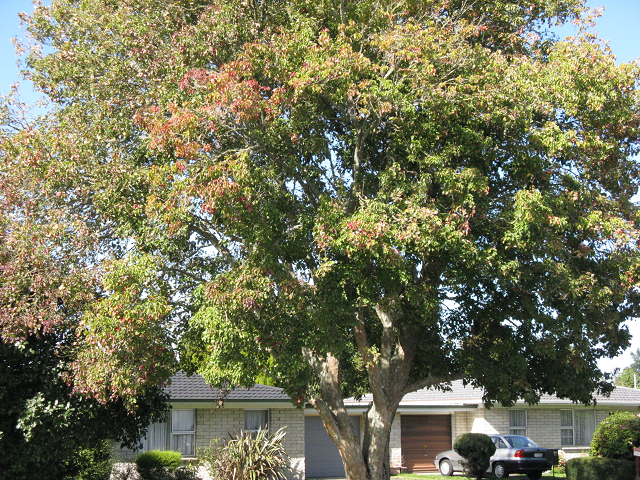
Acer buergerianum
Trident Maple is a small to medium-sized deciduous tree reaching a height of 5–20 m with a trunk up to 50 cm diameter. The leaves are in opposite pairs, 2.5–8 cm long (excluding the 2–5 cm petiole) and 3.5–6.5 cm broad, hard, glossy dark green above, paler below, usually with three lobes; on mature trees the lobes forward-pointing and with smooth margins, on young trees with more spreading lobes and serrated margins. The flowers are produced in spring, yellow-green, in pendulous corymbs; they are small, with five greenish sepals and five yellow-white petals about 2 mm long, and eight stamens. The fruit is a samara with two winged seeds, each seed 4–7 mm diameter, with a 15 mm wing; the wings are forward-pointing and often overlapping each other.
It is widely grown in temperate regions as an ornamental tree. It was introduced very early to Japan, where its name translates as "China maple". More recently, it was introduced to Europe and North America in 1896, and is now occasionally grown in parks and large gardens there
Several interesting cultivars have been developed, many of these bear Japanese names. Notable cultivars include 'Goshiki Kaede' (striking pink and green variegation), 'Kifu Nishiki' (roundish, almost un-lobed leaves), 'Mino Yatsubusa' (dwarf with long, narrow leaves) 'Mitsubato Kaede' (distinctive cork-like trunk) and 'Naruto' (strongly incurved leaf surface).
Maples perform best in a sheltered spot with protection from harsh wind and hot afternoon sun. They don't like to dry out too much in summer and if it is particularly hot and dry extra mulch around the roots will be of benefit. Due to the conditions in my garden I grow a range of Maples in large pots very successfully, with regular watering and feeding they can stay in the same pot for several years. Japanese varieties especially "weepers" suit container planting best.
This tree is in Robinson St.
Quercus coccinea is a very popular North American oak with a large, broadly columnar form. Its leaves are a dark green colour which change to a brilliant, scarlet red colour in autumn. It is also known to have the most brilliant autumn colour of all the oaks. It retains some coppery-coloured foliage during winter. It also withstands droughts once established. Deciduous, grows to 7 x 5m.
Scarlet oak is mainly native to the central and eastern United States, where it is widely distributed. It occurs on dry, sandy, usually acidic soils.
The leaves are glossy green, 7–17 cm long and 8–13 cm broad, lobed, with seven lobes, and with deep sinuses between the lobes. Each lobe has 3-7 bristle-tipped teeth. The leaf is hairless (unlike the related pin oak, which has tufts of pale orange-brown down where the lobe veins join the central vein). The common English name is derived from the autumn coloration of the foliage, which contrasts with pin oak foliage which generally turns bronze in autumn.
The acorns are ovoid, 7–13 mm broad and 17–31 mm long, a third to a half covered in a deep cup, green maturing pale brown about 18 months after pollination. The kernel is very bitter.
This tree is in Bowen St.
The Cambridge Tree Trust was registered with the Charities Commission as a Charitable Entity under the Charities Act 2005 on 16 August 2007. Registration No: CC10859

